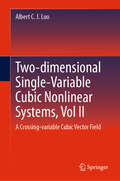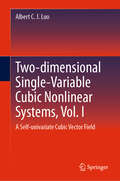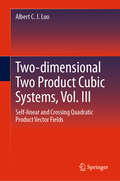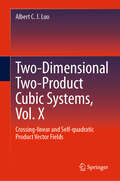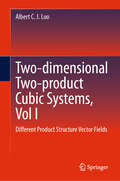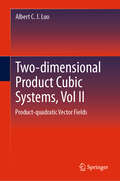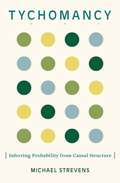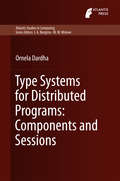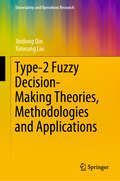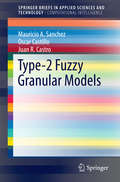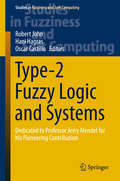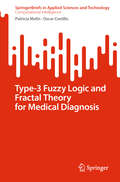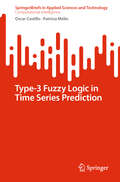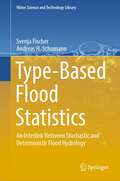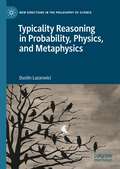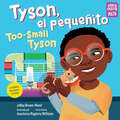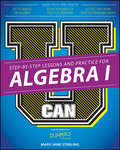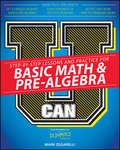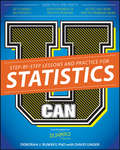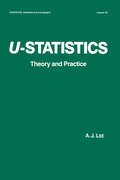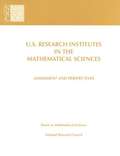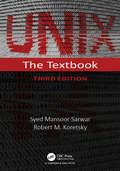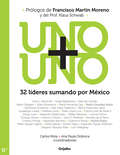- Table View
- List View
Two-dimensional Single-Variable Cubic Nonlinear Systems, Vol II: A Crossing-variable Cubic Vector Field
by Albert C. LuoThis book, the second of 15 related monographs, presents systematically a theory of cubic nonlinear systems with single-variable vector fields. The cubic vector fields are of crossing-variables, which are discussed as the second part. The 1-dimensional flow singularity and bifurcations are discussed in such cubic systems. The appearing and switching bifurcations of the 1-dimensional flows in such 2-diemnsional cubic systems are for the first time to be presented. Third-order parabola flows are presented, and the upper and lower saddle flows are also presented. The infinite-equilibriums are the switching bifurcations for the first and third-order parabola flows, and inflection flows with the first source and sink flows, and the upper and lower-saddle flows. The appearing bifurcations in such cubic systems includes inflection flows and third-order parabola flows, upper and lower-saddle flows. Readers will learn new concepts, theory, phenomena, and analytic techniques, including Constant and crossing-cubic systems Crossing-linear and crossing-cubic systems Crossing-quadratic and crossing-cubic systems Crossing-cubic and crossing-cubic systems Appearing and switching bifurcations Third-order centers and saddles Parabola-saddles and inflection-saddles Homoclinic-orbit network with centers Appearing bifurcations
Two-dimensional Single-Variable Cubic Nonlinear Systems, Vol. I: A Self-univariate Cubic Vector Field
by Albert C. LuoThis book is the first of 15 related monographs, presents systematically a theory of cubic nonlinear systems with single-variable vector fields. The cubic vector fields are of self-variables and are discussed as the first part of the book. The 1-dimensional flow singularity and bifurcations are discussed in such cubic systems. The appearing and switching bifurcations of the 1-dimensional flows in such 2-dimensional cubic systems are for the first time to be presented. Third-order source and sink flows are presented, and the third-order parabola flows are also presented. The infinite-equilibriums are the switching bifurcations for the first and third-order source and sink flows, and the second-order saddle flows with the first and third-order parabola flows, and the inflection flows. The appearing bifurcations in such cubic systems includes saddle flows and third-order source (sink) flows, inflection flows and third-order up (down)-parabola flows.
Two-dimensional Two Product Cubic Systems, Vol. III: Self-linear and Crossing Quadratic Product Vector Fields
by Albert C. LuoThis book is the eleventh of 15 related monographs on Cubic Systems, examines self-linear and crossing-quadratic product systems. It discusses the equilibrium and flow singularity and bifurcations, The double-inflection saddles featured in this volume are the appearing bifurcations for two connected parabola-saddles, and also for saddles and centers. The parabola saddles are for the appearing bifurcations of saddle and center. The inflection-source and sink flows are the appearing bifurcations for connected hyperbolic and hyperbolic-secant flows. Networks of higher-order equilibriums and flows are presented. For the network switching, the inflection-sink and source infinite-equilibriums exist, and parabola-source and sink infinite-equilibriums are obtained. The equilibrium networks with connected hyperbolic and hyperbolic-secant flows are discussed. The inflection-source and sink infinite-equilibriums are for the switching bifurcation of two equilibrium networks.
Two-dimensional Two-product Cubic Systems Vol. X: Crossing-linear and Self-quadratic Product Vector Fields
by Albert C. LuoThis book is the tenth of 15 related monographs, discusses product-cubic nonlinear systems with two crossing-linear and self-quadratic products vector fields and the dynamic behaviors and singularity are presented through the first integral manifolds. The equilibrium and flow singularity and bifurcations discussed in this volume are for the appearing and switching bifurcations. The double-saddle equilibriums described are the appearing bifurcations for saddle source and saddle-sink, and for a network of saddles, sink and source. The infinite-equilibriums for the switching bifurcations are also presented, specifically: · Inflection-saddle infinite-equilibriums, · Hyperbolic (hyperbolic-secant)-sink and source infinite-equilibriums · Up-down and down-up saddle infinite-equilibriums, · Inflection-source (sink) infinite-equilibriums.
Two-dimensional Two-product Cubic Systems, Vol I: Different Product Structure Vector Fields
by Albert C. LuoThis book is the ninth of 15 related monographs, discusses a two product-cubic dynamical system possessing different product-cubic structures and the equilibrium and flow singularity and bifurcations for appearing and switching bifurcations. The appearing bifurcations herein are parabola-saddles, saddle-sources (sinks), hyperbolic-to-hyperbolic-secant flows, and inflection-source (sink) flows. The switching bifurcations for saddle-source (sink) with hyperbolic-to-hyperbolic-secant flows and parabola-saddles with inflection-source (sink) flows are based on the parabola-source (sink), parabola-saddles, inflection-saddles infinite-equilibriums. The switching bifurcations for the network of the simple equilibriums with hyperbolic flows are parabola-saddles and inflection-source (sink) on the inflection-source and sink infinite-equilibriums. Readers will learn new concepts, theory, phenomena, and analysis techniques. · Two-different product-cubic systems · Hybrid networks of higher-order equilibriums and flows · Hybrid series of simple equilibriums and hyperbolic flows · Higher-singular equilibrium appearing bifurcations · Higher-order singular flow appearing bifurcations · Parabola-source (sink) infinite-equilibriums · Parabola-saddle infinite-equilibriums · Inflection-saddle infinite-equilibriums · Inflection-source (sink) infinite-equilibriums · Infinite-equilibrium switching bifurcations.
Two-dimensional Product-cubic Systems, Vol.II: Product-quadratic Vector Fields
by Albert C. LuoThis book, the sixth of 15 related monographs, discusses singularity and networks of equilibriums and 1-diemsnional flows in product quadratic and cubic systems. The author explains how, in the networks, equilibriums have source, sink and saddles with counter-clockwise and clockwise centers and positive and negative saddles, and the 1-dimensional flows includes source and sink flows, parabola flows with hyperbolic and hyperbolic-secant flows. He further describes how the singular equilibriums are saddle-source (sink) and parabola-saddles for the appearing bifurcations, and the 1-dimensional singular flows are the hyperbolic-to-hyperbolic-secant flows and inflection source (sink) flows for 1-dimensional flow appearing bifurcations, and the switching bifurcations are based on the infinite-equilibriums, including inflection-source (sink), parabola-source (sink), up-down and down-up upper-saddle (lower-saddle), up-down (down-up) sink-to-source and source-to-sink, hyperbolic and hyperbolic-secant saddles. The diagonal-inflection upper-saddle and lower-saddle infinite-equilibriums are for the double switching bifurcations. The networks of hyperbolic flows with connected saddle, source and center are presented, and the networks of the hyperbolic flows with paralleled saddle and center are also illustrated. Readers will learn new concepts, theory, phenomena, and analysis techniques. Product-quadratic and product cubic systems Self-linear and crossing-quadratic product vector fields Self-quadratic and crossing-linear product vector fields Hybrid networks of equilibriums and 1-dimensional flows Up-down and down-up saddle infinite-equilibriums Up-down and down-up sink-to-source infinite-equilibriums Inflection-source (sink) Infinite-equilibriums Diagonal inflection saddle infinite-equilibriums Infinite-equilibrium switching bifurcations
Two-sided matching
by Alvin E. Roth Marilda A. Oliveira SotomayorTwo-sided matching provides a model of search processes such as those between firms and workers in labor markets or between buyers and sellers in auctions. This book gives a comprehensive account of recent results concerning the game-theoretic analysis of two-sided matching. The focus of the book is on the stability of outcomes, on the incentives that different rules of organization give to agents, and on the constraints that these incentives impose on the ways such markets can be organized. The results for this wide range of related models and matching situations help clarify which conclusions depend on particular modeling assumptions and market conditions, and which are robust over a wide range of conditions.
Tychomancy
by Michael StrevensTychomancy-meaning the divination of chances-presents a set of rules for inferring the physical probabilities of outcomes from the causal or dynamic properties of the systems that produce them. Probabilities revealed by the rules are wide-ranging: they include the probability of getting a 5 on a die roll, the probability distributions found in statistical physics, and the probabilities that underlie many prima facie judgments about fitness in evolutionary biology. Michael Strevens makes three claims about the rules. First, they are reliable. Second, they are known, though not fully consciously, to all human beings: they constitute a key part of the physical intuition that allows us to navigate around the world safely in the absence of formal scientific knowledge. Third, they have played a crucial but unrecognized role in several major scientific innovations. A large part of Tychomancy is devoted to this historical role for probability inference rules. Strevens first analyzes James Clerk Maxwell’s extraordinary, apparently a priori, deduction of the molecular velocity distribution in gases, which launched statistical physics. Maxwell did not derive his distribution from logic alone, Strevens proposes, but rather from probabilistic knowledge common to all human beings, even infants as young as six months old. Strevens then turns to Darwin’s theory of natural selection, the statistics of measurement, and the creation of models of complex systems, contending in each case that these elements of science could not have emerged when or how they did without the ability to eyeball the values of physical probabilities.
Type Systems for Distributed Programs: Components and Sessions
by Ornela DardhaIn this book we develop powerful techniques based on formal methods for the verification of correctness, consistency and safety properties related to dynamic reconfiguration and communication in complex distributed systems. In particular, static analysis techniques based on types and type systems are an adequate methodology considering their success in guaranteeing not only basic safety properties, but also more sophisticated ones like deadlock or lock freedom in concurrent settings. The main contributions of this book are twofold. i) We design a type system for a concurrent object-oriented calculus to statically ensure consistency of dynamic reconfigurations. ii) We define an encoding of the session pi-calculus, which models communication in distributed systems, into the standard typed pi-calculus. We use this encoding to derive properties like type safety and progress in the session pi-calculus by exploiting the corresponding properties in the standard typed pi-calculus.
Type Theory and Formal Proof
by Rob Nederpelt Herman GeuversType theory is a fast-evolving field at the crossroads of logic, computer science and mathematics. This gentle step-by-step introduction is ideal for graduate students and researchers who need to understand the ins and outs of the mathematical machinery, the role of logical rules therein, the essential contribution of definitions and the decisive nature of well-structured proofs. The authors begin with untyped lambda calculus and proceed to several fundamental type systems, including the well-known and powerful Calculus of Constructions. The book also covers the essence of proof checking and proof development, and the use of dependent type theory to formalise mathematics. The only prerequisite is a basic knowledge of undergraduate mathematics. Carefully chosen examples illustrate the theory throughout. Each chapter ends with a summary of the content, some historical context, suggestions for further reading and a selection of exercises to help readers familiarise themselves with the material.
Type-2 Fuzzy Decision-Making Theories, Methodologies and Applications (Uncertainty and Operations Research)
by Jindong Qin Xinwang LiuThis book integrates the type-2 fuzzy sets and multiple criteria decision making analysis in recent years and offers an authoritative treatise on the essential topics, both at the theoretical and applied end. In this book, some basic theory, type-2 fuzzy sets, methodology, algorithms, are introduced and then some compelling case studies in decision problems are covered in depth. The authors offer an authoritative treatise on the essential topics, both at the theoretical and applied end; In a systematic and logically organized way, the book exposes the reader to the essentials of the theory of type-2 fuzzy sets, methodology, algorithms, and their applications. Numerous techniques of decision making are carefully generalized by bringing the ideas of type-2 fuzzy sets; this concerns well-known methods including TOPSIS, Analytical Network Process, TODIM, and VIKOR. This book exposes the readers to the essentials of the theory of type-2 fuzzy sets, methodology, algorithms, and their applications.
Type-2 Fuzzy Granular Models
by Oscar Castillo Mauricio A. Sanchez Juan R. CastroIn this book, a series of granular algorithms are proposed. A nature inspired granular algorithm based on Newtonian gravitational forces is proposed. A series of methods for the formation of higher-type information granules represented by Interval Type-2 Fuzzy Sets are also shown, via multiple approaches, such as Coefficient of Variation, principle of justifiable granularity, uncertainty-based information concept, and numerical evidence based. And a fuzzy granular application comparison is given as to demonstrate the differences in how uncertainty affects the performance of fuzzy information granules.
Type-2 Fuzzy Logic and Systems: Dedicated to Professor Jerry Mendel for his Pioneering Contribution (Studies in Fuzziness and Soft Computing #362)
by Oscar Castillo Hani Hagras Robert JohnThis book explores recent perspectives on type-2 fuzzy sets. Written as a tribute to Professor Jerry Mendel for his pioneering works on type-2 fuzzy sets and systems, it covers a wide range of topics, including applications to the Go game, machine learning and pattern recognition, as well as type-2 fuzzy control and intelligent systems. The book is intended as a reference guide for the type-2 fuzzy logic community, yet it aims also at other communities dealing with similar methods and applications.
Type-3 Fuzzy Logic and Fractal Theory for Medical Diagnosis (SpringerBriefs in Applied Sciences and Technology)
by Oscar Castillo Patricia MelinThis book is intended to be a reference for scientists and engineers interested in applying type-3 fuzzy logic and fractal theory techniques in medical diagnosis. In this book, a new model based on type-3 fuzzy logic and fractal theory for applications in medical diagnosis is presented. The main idea is that a higher type and order of fuzzy logic can help in solving various diagnosis problems and find better results. In addition, fractal theory is also employed for enhancing medical diagnosis. In this regard, several hybrid intelligent methods are offered. In this book, the authors test the proposed methods using several medical diagnosis problems, like diagnosis of problems in the brain, hearth, lungs, and others. The authors can notice that when type-3 fuzzy systems are implemented to model the behavior of systems, the results in diagnosis are enhanced, because the management of uncertainty is better. For this reason, the authors consider in this book the proposed methods using type-3 fuzzy systems and fractal theory to improve the diagnosis in complex medical problems.
Type-3 Fuzzy Logic in Time Series Prediction (SpringerBriefs in Applied Sciences and Technology)
by Oscar Castillo Patricia MelinThis book focuses on the field of type-3 fuzzy logic for applications in time series prediction. The main idea is that a higher type and order of fuzzy logic can help in solving various prediction problems and find better results. In addition, neural networks and fractal theory are employed in enhancing prediction results. In this regard, several hybrid intelligent methods are offered. In this book we test the proposed methods using several prediction problems, like predicting COVID-19 and the stock market. We can notice that when Type-3 fuzzy systems are implemented to model the behavior of systems, the results in prediction are enhanced, because the management of uncertainty is better. For this reason, we consider in this book the proposed methods using type-3 fuzzy systems, neural networks and fractal theory to improve the prediction behavior of the complex nonlinear systems. This book is intended to be a reference for scientists and engineers interested in applying type-3 fuzzy logic techniques for solving complex prediction problems. This book can also be used as a reference for graduate courses like the following: soft computing, fuzzy logic, neural networks, bio-inspired algorithms, intelligent prediction, and similar ones. We consider that this book can also be used to get novel ideas for new lines of research, or to continue the lines of research proposed by the authors of the book.
Type-Based Flood Statistics: An Interlink Between Stochastic and Deterministic Flood Hydrology (Water Science and Technology Library #124)
by Andreas H. Schumann Svenja FischerThis book summarises for the first time all relevant methodologies for type-based flood statistics, introduces the basis of flood typology and makes them accessible to the user. Flood types improve the understanding of the flood-generating processes and characterise the flood event in terms of its features such as peak, volume and hydrograph shape. In addition, they can also significantly expand the information used in flood statistics and add valuable flood characteristics to the determination of design floods, especially the determination of flood scenarios relevant for reservoir management. A detailed framework with all aspects of point and spatial statistics as well as regionalisation is presented, and examples illustrate the benefit of the proposed methodology. The target audience is both users in associations and engineering offices, as type-based statistics are increasingly becoming part of the specifications, and researchers, as this is a current field of research.
Typicality Reasoning in Probability, Physics, and Metaphysics (New Directions in the Philosophy of Science)
by Dustin LazaroviciThis book provides a comprehensive investigation into the concept of typicality and its significance for physics and the philosophy of science. It identifies typicality as a fundamental way of reasoning, central to how natural laws explain and are tested against phenomena. The book discusses various applications of typicality to foundational questions in physics and beyond.These include:a unified interpretation of objective probabilities in classical mechanics and quantum mechanicsa detailed discussion of Boltzmann's statistical mechanics, entropy, and the second law of thermodynamicsa novel account of the asymmetry of causation and the arrow of time Finally, the book turns to the question: "What are laws of nature"? It argues that typicality extends to a powerful way of reasoning in metaphysics that can and should inform our commitments about the fundamental ontology of the world. On this basis, it develops an argument against the Humean best system account, according to which laws of nature are merely an efficient summary of contingent regularities.
Tyson, el pequeñito / Too-Small Tyson (Storytelling Math)
by JaNay Brown-WoodCelebrate diversity, math, and the power of storytelling with this bilingual (Spanish and English) edition!Tyson is the youngest, smaller than his four older brothers and always trying to keep up. But when the family&’s pet gerbil, Swish, goes missing, it&’s Tyson to the rescue! Tyson uses his knowledge of doubles, triples, and sizes to figure out a clever way to reach his beloved pet. A playful exploration of proportional thinking, featuring Black characters and an author letter about the ubiquitous nature of math. Tyson es el más joven y el más pequeñito de cuatro hermanos. Siempre está tratando de seguirles el ritmo. Pero cuando Swish, el gerbo de la familia, se pierde, ¡Tyson es el que va al rescate! Tyson aplica lo que sabe sobre dobles, triples y tamaño para planear de forma inteligente cómo encontrar a su mascota. Este cuento es una exploración entretenida del razonamiento proporcional, presentando personajes afroamericanos e incluyendo una carta de la autora sobre la naturaleza ubicua de las matemáticas.The Storytelling Math series shows that all children can be mathematical thinkers. Each book includes ideas for exploring math at home with your children and was developed in collaboration with math experts at STEM education nonprofit TERC, under a grant from the Heising-Simons Foundation.
U Can: Algebra I For Dummies
by Mary Jane SterlingThere's no denying that Algebra is hard. Lucky for students, U Can makes it easier. Students will find all of the no-nonsense, how-to content they need, paired with practical examples and practice problems they want, PLUS access to 1,001 more algebra practice problems online. In U Can: Algebra I For Dummies, lessons and practice are fully integrated, creating a product that combines the "how to" with the "do it" to form one perfect resource for students.
U Can: Basic Math and Pre-Algebra For Dummies
by Mark ZegarelliThe fun and friendly guide to really understanding math U Can: Basic Math & Pre-Algebra For Dummies is the fun, friendly guide to making sense of math. It walks you through the "how" and "why" to help you master the crucial operations that underpin every math class you'll ever take. With no-nonsense lessons, step-by-step instructions, practical examples, and plenty of practice, you'll learn how to manipulate non-whole numbers, tackle pesky fractions, deal with weights and measures, simplify algebraic expressions, and so much more. The "learn it – do it" style helps you move at your own pace, with lesson-sized explanations, examples, and practice. You also get access to 1,001 more practice problems online, where you can create customized quizzes and study the topics where you need the most help. Math can be hard — and the basics in U Can: Basic Math & Pre-Algebra For Dummies lay the foundation for classes down the line. Consider this resource as your guide to math mastery, with step-by-step help for learning to: Put numbers in their place Make sense of fractions, decimals, and percents Get a grasp of basic geometry Simplify basic algebraic equations Believe it or not, math can be fun! And the better you understand it now, the more likely you are to do well in school, earn a degree, and get a good job. U Can: Basic Math & Pre-Algebra For Dummies gives you the skills, understanding, and confidence you need to conquer math once and for all.
U Can: Statistics For Dummies
by David Unger Deborah J. RumseyMake studying statistics simple with this easy-to-read resource Wouldn′t it be wonderful if studying statistics were easier? With U Can: Statistics I For Dummies, it is! This one-stop resource combines lessons, practical examples, study questions, and online practice problems to provide you with the ultimate guide to help you score higher in your statistics course. Foundational statistics skills are a must for students of many disciplines, and leveraging study materials such as this one to supplement your statistics course can be a life-saver. Because U Can: Statistics I For Dummies contains both the lessons you need to learn and the practice problems you need to put the concepts into action, you′ll breeze through your scheduled study time. Statistics is all about collecting and interpreting data, and is applicable in a wide range of subject areas which translates into its popularity among students studying in diverse programs. So, if you feel a bit unsure in class, rest assured that there is an easy way to help you grasp the nuances of statistics! Understand statistical ideas, techniques, formulas, and calculations Interpret and critique graphs and charts, determine probability, and work with confidence intervals Critique and analyze data from polls and experiments Combine learning and applying your new knowledge with practical examples, practice problems, and expanded online resources U Can: Statistics I For Dummies contains everything you need to score higher in your fundamental statistics course!
U-Statistics: Theory and Practice
by A J. LeeIn 1946 Paul Halmos studied unbiased estimators of minimum variance, and planted the seed from which the subject matter of the present monograph sprang. The author has undertaken to provide experts and advanced students with a review of the present status of the evolved theory of U-statistics, including applications to indicate the range and scope of U-statistic methods. Complete with over 200 end-of-chapter references, this is an invaluable addition to the libraries of applied and theoretical statisticians and mathematicians.
U.S. Research Institutes in the Mathematical Sciences: Assessment and Perspectives
by Committee on U.S. Mathematical Sciences Research InstitutesThe Committee on U.S. Mathematical Sciences Research Institutes was charged with characterizing the role that such institutes currently play in furthering research in the mathematical sciences1 and with evaluating the advisability of changing or expanding that role.
UNIX: The Textbook, Third Edition
by Syed Mansoor Sarwar Robert M. KoretskyUNIX: The Textbook, Third Edition provides a comprehensive introduction to the modern, twenty-first-century UNIX operating system. The book deploys PC-BSD and Solaris, representative systems of the major branches of the UNIX family, to illustrate the key concepts. It covers many topics not covered in older, more traditional textbook approaches, such as Python, UNIX System Programming from basics to socket-based network programming using the client-server paradigm, the Zettabyte File System (ZFS), and the highly developed X Windows-based KDE and Gnome GUI desktop environments. The third edition has been fully updated and expanded, with extensive revisions throughout. It features a new tutorial chapter on the Python programming language and its use in UNIX, as well as a complete tutorial on the git command with Github. It includes four new chapters on UNIX system programming and the UNIX API, which describe the use of the UNIX system call interface for file processing, process management, signal handling, interprocess communication (using pipes, FIFOs, and sockets), extensive coverage of internetworking with UNIX TCP/IP using the client-server software, and considerations for the design and implementation of production-quality client-server software using iterative and concurrent servers. It also includes new chapters on UNIX system administration, ZFS, and container virtualization methodologies using iocage, Solaris Jails, and VirtualBox. Utilizing the authors’ almost 65 years of practical teaching experience at the college level, this textbook presents well-thought-out sequencing of old and new topics, well-developed and timely lessons, a Github site containing all of the code in the book plus exercise solutions, and homework exercises/problems synchronized with the didactic sequencing of chapters in the book. With the exception of four chapters on system programming, the book can be used very successfully by a complete novice, as well as by an experienced UNIX system user, in both an informal and formal learning environment. The book may be used in several computer science and information technology courses, including UNIX for beginners and advanced users, shell and Python scripting, UNIX system programming, UNIX network programming, and UNIX system administration. It may also be used as a companion to the undergraduate and graduate level courses on operating system concepts and principles.
UNO + UNO
by Ana Paula Ordorica"Carlos y Ana Paula convocaron a personajes mexicanos exitosos y en sus treinta para pedirles que les contaran cuáles son las herramientas para tener un mejor futuro." Revista CARAS Los mexicanos nacidos en los años setenta, mujeres y hombres, ya están tomando muchas de las decisiones que dibujarán el futuro de México. Como nos muestra esta espléndida y variada recopilación que han hecho Ana Paula Ordorica y Carlos Mota, el denominador común de las acciones, metas y sueños de estos jóvenes, desde talentosas directoras de orquesta hasta empresarios exitosos, pasando por talentosos deportistas, es la esperanza. No sólo claman por un México mejor, lo están construyendo. Vale la pena prestarle una esmerada atención a este llamado entusiasta.
